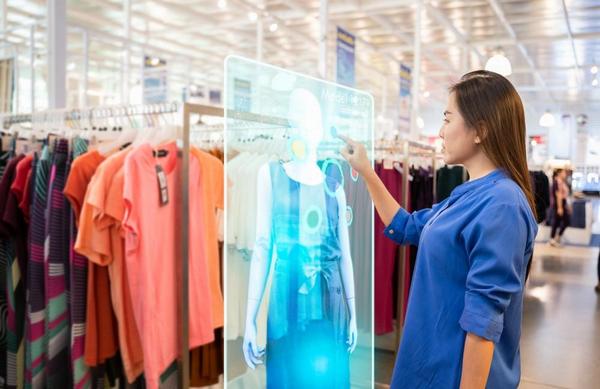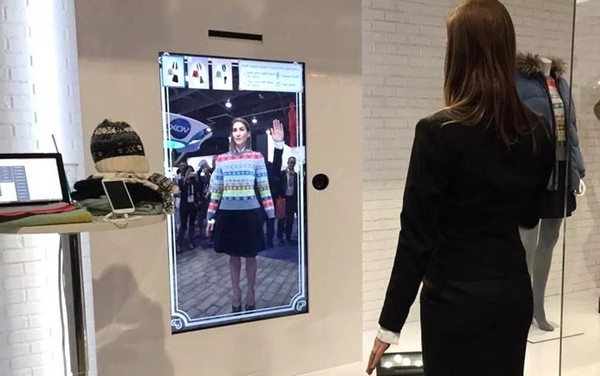Technology Trends that is Reshaping the Fashion Industry
Manisha Beniwal
Department of Textiles (Fashion Technology)
DKTE’S Textile & Engineering Institute, Ichalkaranji, India
Email: manishabeniwal2920@gmail.com
Introduction:
The fashion industry encompasses numerous different lower and further niche diligence. Frequently people suppose of it as just retail online stores, design houses and brands, and fashion magazines. Still, there are other handicraftsmen and diligence in the manufacturing of clothes. Utmost obviously, there are those that make and vend fabric and sundries, but there are also flower makers, embroiders, seamstresses knitters, and numerous others. When it comes to fashion shows and fashion marketing there are models, hairstylists, hair hairstylists, make- up artists, model agents, photographers, and a host of other non-fashion business that all make up a larger fashion eco-system.
The rise of the Internet has impacted all corridor of the fashion industry, not just the selling end of the industry. It has a part in force chains, advertising, dispatches, brand mindfulness, etc and blurred the line between business and consumer. Social media channels haven’t just come important to the selling of fashion but also as part of forecasting and determining unborn trends. Social media spots like Instagram and TikTok are playing an adding part in fashion particularly when it comes to relating and spreading trends and hot particulars of the moment. Social media also speeds up the hot v not cycle and gave life to the micro trend. Bloggers and other influencers may help sell products, but can also be used by” Fashion foretellers” looking for what is coming by looking at Instagram.

The traditional view of fashion’s infrastructure, as substantiated in the text The Dynamics of Fashion, there are four situations of the fashion assiduity the primary position of cloth product, including manufactories and yarn makers; the secondary position of contrivers, manufacturers, wholesalers, and merchandisers; the retail position, which includes all types of stores and distribution points of trade; and also a fourth position the supplementary position which connects each of the other situations via the press, advertising, exploration agencies, advisers , and fashion foretellers who play a part in the merchandise’s progression to the end consumer. While the relationship between the situations is more or less symbiotic- they need one another to survive historically, the competitive spirit of capitalism has also created a pressure between retailer and manufacturer, where the balance of power is generally sloped to one side in the race to capture gains and perimeters. The degree to which each side benefits financially from the trade of vesture has changed gradationally over the decades, subject to numerous factors from social advancements to profitable swings to religions of developer personalities to wars- both between countries and empires. Over the century, the retailer, in numerous cases, has taken on the part of the manufacturer, and manufacturers have come retailers of their own designs.
Technology Trends in Fashion Industry:
Nowadays there are number of technologies that are reshaping the fashion industry. Numerous designers and brands must embrace the rearmost technologies to push the limits of manufacturing, product, marketing, and wearability as customer real lives come decreasingly intertwined with the digital world. From artificial intelligence to the rise of mobile commerce, 3D printing, and blockchain, we have collected a list of the top tech advancements in fashion moment
Different technology trends in fashion industry that are found:
1. Artificial Intelligence (AI):
In recent times, brands have used artificial intelligence (AI) to ameliorate the shopping experience of their customers, dissect data, increase deals, forecast trends, and give force- related guidance. Chatbots and touchscreens are being used in stores to ameliorate client experience and customized product suggestions. It’s nearly insolvable to head to a fashion brand’s website and not find some form of AI converse technology that’s being used to help enhance the client experience. The technology behind AI includes algorithms that track guests’ peregrinations to match them with the right products.

2. Internet of Things (IoT):
The IoT describes a network of objects- the ‘effects ’- that are embedded with technology to allow the exchange and connection of data over the internet. This is one of the most instigative, arising technological trends in the fashion request. Time on time, everyday fashion continues to ameliorate to reflect the realities of our diurnal lives. From a great emphasis on comfort to using new and instigative fabrics, the fashion assiduity has had to keep up the pace in conforming to the demands of contemporary life. This has been seen most easily in the instigative advancements in vesture technology and wearable widgets. These have gone as far as affecting how we witness our surroundings, interact with others and our bodies, giving the word comfort a whole new meaning. Smart apparel, wearable spaces, multi-functional designs, and responsive sportswear have all largely developed over the once three times.
A virtual actuality numerous contrivers have been experimenting and pushing the limits of what wearability means.
3. Virtual and Augmented Reality:
Combining the physical and online worlds of retail has been one of Virtual Reality’s most instigative operations. This is clearly true in the fashion assiduity one wide use of VR is enabling guests to nearly try on outfits. This gives lesser delicacy, thanks to customized dimension functionality, and also employs stoked reality technology. It also means that guests might be more likely to buy products they feel that they’re tried on. This kind of online shopping experience engages and retains the guests longer, as they love seeing the product on themselves before buying. This combined with the social media share factor.

4. 3D Printing:
The advent of 3D printers, numerous brands, both big and small, have been looking into the possibilities it holds for on- demand product. This will produce new avenues for customization, sustainability, and creativity.

Numerous fashion brands are embracing 3D in their collections in 2022, from accessories to full aesthetics. Despite the fact it takes numerous hours to produce, it results in lower waste and proves far lower labour- ferocious than other types of manufacturing. Indeed, publishing garments on- demand reduces fabric waste by about 35. This minimum waste approach could give precious perceptivity on how to reshape the current state of manufactures and align them with a more sustainable social and environmental focus.
5. Blockchain:
Blockchain is substantially used as a record- keeping technology behind bitcoin and digital currency.” Blocks” on the blockchain are made up of digital pieces of data that store information about deals like the date, time, and bone quantum of your most recent purchase, as well as who’s sharing in the deals. Still, they also store information that distinguishes them from other blocks, using a unique law called a hash. The blockchain result creates a physical- digital link between products and their digital individualities on a blockchain. Just like with digital currency, Blockchain offers a cryptographic seal or periodical number that acts as the physical identifier which is linked back to the industry individual product. Each time a product moves in the force chain it’s recorded on the blockchain. This can help counterfeiting as goods that are missing the physical- digital link will be egregious fakes. Also, any attempt to divert goods can be tracked. This identifies if the last party to gain guardianship of the product, had a fake product slipped in — or if the authentic product was diverted out.
6. Mobile Commerce:
Mobile technology is getting more advanced every day. From Instagram shopping to smart holdalls, mobile commerce is the ultimate tech tool. It has not only impacted our everyday lives, but it has come one of the swift- growing sectors in ecommerce. This is because using our smartphones for shopping online is getting easier and easier. With digital portmanteau options like Apple and Android Pay, constantly instituting with new technologies like point and facial recognition, they are poised to come the favoured payment for retail purchases. In fact, according to Big Commerce, two out of three millennials would rather protect online than in- store. Still, on top of e-commerce growth, we throw social media into the blend, If. This gives them lesser visibility and provides them with further openings to make a trade.
7. Rapid Data Analysis for Quick Adaptations:
Rapid data analysis, for quick adaption, is a way for businesses to snappily acclimatize their business fractions (similar as the force chain) snappily and efficiently through using large quantities of data to support this adaptation. Thanks to the new software tools available on the request, brands, and manufactories can admit real- time feedback and cautions from companies about blights or damaged goods. This helps them save plutocrat, exclude waste and deliver acceptable products at the right time. It also lets them maximize client satisfaction by feting implicit business pitfalls incontinently. One illustration is operation software like IQMS. The enterprise resource planning (ERP) software is used in manufacturing for monitoring and collecting the product data in real- time, as products are being made.
8. Hyper- Personalization:
Fashion brands are increasingly turning to personalization to produce new designs and offer custom options. Cumulative manufacturing allows companies to acclimatize to consumer requirements and develop sustainable and eco-friendly results for the fashion assiduity. also, it enables demand- driven product to help overproduction. Startups are also developing fashion gaming results to enhance personalization, increase youngish consumers’ engagement, and give shoppable virtual fashion means and physical clothes.
9. Fashion Live Streaming:
The rise of digitalization, consumers are spending further time on digital media. This is why fashion brands are using live streaming to offer digital content to their target cult. The live shopping trend combines the benefits of social media and at- home shopping. It provides consumers with an immersive and interactive experience as well as fosters a sense of community with their guests. Technologies similar as 5G are perfecting the quality of live streaming and promoting further interactive content and accessible eCommerce features.
Conclusion:
Therefore fashion industry is upcoming with different technology trends that are increasing the different innovations in the fashion industry and therefore it is bringing demands and increasing the customer experience by giving them opportunity to experience through different technologies.
References:
- Top 9 Technology Trends Reshaping The Fashion Industry In 2023. Retrieved on February 7, from https://techpacker.com/blog/design/top-9-fashion-technology-trends/
- Top 8 Fashion Technology Trends & Innovations in 2023. Retrieved on February 12, from https://www.startus-insights.com/innovators-guide/fashion-technology-trends/
- Fashion Industry: A Resource Guide. Retrieved on February 7, from https://guides.loc.gov/fashion-industry
- Anticipating the Wants of the Consumer .Retrieved on February 7, from https://womens-fashion.lovetoknow.com/womens-fashion-history/evolution-fashion-industry
- The future of fashion: What’s next for fashion technology?. Retrieved on February 7, from https://www.futurelearn.com/info/blog/fashion-technology
You may also like:
- Applications of Artificial Intelligence in Textile Industry
- Automation and Robotic in Sewing Technology
